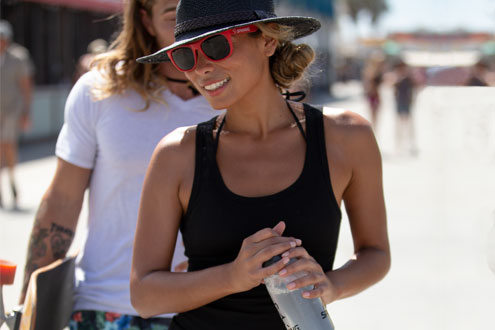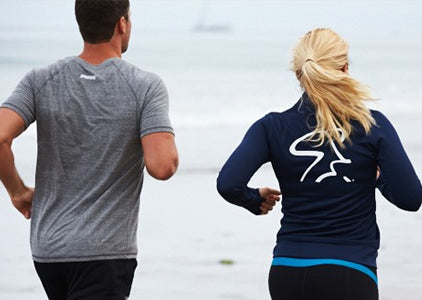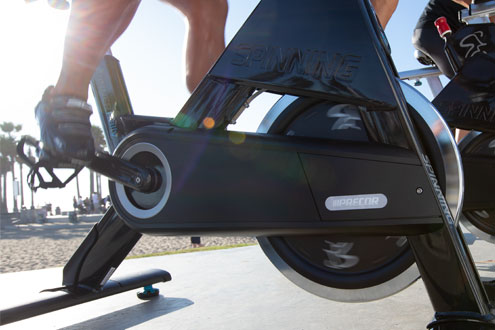By John Cargill, Spinning® Master Instructor | Illinois, United States
You may have at least heard of electrolytes, and most serious endurance athletes must monitor their intake in order to avoid bodily breakdowns on the road to glory. YouTube videos, which feature footage of some beleaguered competitor becoming sick roadside, are enough to make anyone wary of suffering an electrolyte imbalance.
Perhaps closer to home, you may have attended a Spinning® or indoor cycling training class and found that mere water was unequal to the task of hydrating the body for those journey rides beyond 40 minutes. If you train outdoors and/or in hot environments, electrolyte replacement is even more critical.
What Are Electrolytes?
Electrolytes are ions that are best described as very small, electrically charged particles that are mobilized by the water in our bodies that serve a plurality of functions. The six most commonly known electrolytes: sodium, potassium, magnesium, calcium, phosphate, and chloride.
Some of the key functions they serve, which are especially important during activity, include:
- Heart function (sodium and potassium)
- Maintaining water levels (sodium)
- Neural and muscular excitation (sodium and chloride)
- Muscular contraction (calcium)
- Cellular operations (magnesium)
Why is Sodium So Important?
Our bodies, in order to perform as they were intended to, require electrolyte balance—neither too much nor too little. Although excess concentrations of any given electrolyte are possible, and indeed such conditions have been diagnosed and treated, it remains far more commonplace for individuals, and especially endurance athletes, to become depleted or deficient of one electrolyte in particular: sodium. Hyponatremia, or water intoxication, is a deficient sodium concentration and one of the many potential complications that can occur with unchecked sodium losses and too much water intake.
How does one lose so much sodium? The simplest answer is perspiration, or sweat. A discussion about sweat and sweat rates raises some important questions. How long is the training session? What discipline is on the schedule (e.g., indoor cycling training, running, rowing)? How intense is the training session (e.g., long distance workout, tempo/threshold, intervals, some combination)? Will it be indoors or outdoors? These variables have a profound influence on both energy expenditure and sweat rates, and they warrant careful consideration.
How Do I Hydrate and Balance Electrolytes?
You now have many options to optimize your hydration and nutrition before, during and after your event. Each brand offers its own solutions to energy and electrolyte problems. On a more humorous note, we have certainly come a long way since a popular American beer brand was the primary sponsor of the Kona Ironman®.
While I am not going to embrace or disparage any product here, we can establish some facts about some of the fuels and hydration systems. Most brands contain some electrolyte replacement, such as sodium and potassium. Others provide for glucose (sugar) replacement. Another important note, check to see if the product is water-soluble (most are), so you will need to consume the product, for instance gels or tablets, with water.
Which Electrolyte and Glucose Product Is Right for Me?
Before you buy a bunch of products, consider if you actually require all electrolytes to be present—recalling that deficiencies in phosphate, chloride, potassium, magnesium, and calcium are somewhat infrequent. The sodium and potassium present in common sports drinks may be adequate in many cases, but the glucose content needs to be examined as well—make sure you have the right product or mix of products that works well for you.
Make sure you figure out what works for you before race day—every body is different, and so is your digestive system. For instance, for some people, consuming glucose gels and a sports drink, gastric emptying problems (bloating) may ensue. One way around this is to use a low sugar beverage option or dilute a beverage with water. Another possible alternative may be salt or electrolyte tablets in water and supplemented with gels for glucose replacement.
Gastric emptying may also be a problem with solid nutrition, and, in fact, my experience on the competitive circuit has shown that bars are not as frequently used for electrolytes or refueling during an event; they are more often used pre- and post-event. I have heard of gastric emptying problems that present with gels in some individuals, too, and in that case there are powdered products available that contain electrolytes and glucose. These may simply be dissolved in water, and their benefits are quite similar to those of common sports drinks.
How Do I Get Ready for Race Day?
Clearly there are quite a few options out there. My advice would be to know your body and how it responds to various routines, such as indoor cycling training and endurance training. If you are not certain what your electrolyte needs are, train with the product(s) that match up with what you think you need, then note your response and reevaluate if necessary.
Do you simply require electrolytes or do you need electrolytes and calories rolled into one item? Many of the most important determinations about these matters have been made through trial and error. So put the products on trial, and don’t be afraid to learn what is best from the error(s). Regardless of what the advertising or marketing of a product may be, the one truth is that you should obey your own body first.






Leave a comment
This site is protected by hCaptcha and the hCaptcha Privacy Policy and Terms of Service apply.